A Lower Sodium Neapolitan Pizza Prepared with Seawater in Place of Salt: Nutritional Properties, Sensory Characteristics, and Metabolic Effects
Abstract
1. Introduction and Aim
2. Materials and Methods
2.1. The Pizzas
2.2. Measurement of the Pizzas’ Sodium Chloride Content (the Mohr Method)
2.3. Mineralization of the Samples
2.4. Inductively Coupled Plasma-Optical Emission Spectrometry (ICP-OES) Analysis
2.5. Volatile Molecules Analysis
2.6. RCT Design
2.7. Participants and Study Protocol
2.8. Statistical Analysis
2.9. Power Analysis
3. Results
3.1. Study Participants
3.2. Nutritional Characteristics of the Pizzas
3.3. Volatile Profile of the Two Pizzas
3.4. Sensory Analysis
3.5. Satiating Power
3.6. Serum Glucose and Insulin Response
3.7. Sodium Metabolism
4. Discussion
- (1)
- A 50% lower sodium Neapolitan pizza, made using seawater in place of common salt, was perceived as less salty yet not less tasty, palatable and pleasant as the one made with the traditional recipe. Moreover, no differences were detected in the satiating power.
- (2)
- The SWP provided a biologically significant additional amount of minerals, such as calcium, potassium, magnesium, selenium and iodine, for which the recommended intake is not reached by a large proportion of the paediatric and the adult population.
- (3)
- The SWP had a larger content of some volatile molecules partly produced during the baking process, contributing to the aroma of the pizza.
- (4)
- The consumption of the SWP was associated in the post-prandial period with a significantly larger urine volume and the urinary excretion of a much larger proportion of the sodium ingested compared with StP in face of a similar degree of hydration.
- (5)
- The consumption of SWP and StP provided similar effects on the glycaemic and insulinemic responses to the meal.
5. Conclusions and Perspectives
Supplementary Materials
Author Contributions
Funding
Acknowledgments
Conflicts of Interest
References
- Strazzullo, P.; D’Elia, L.; Kandala, N.B.; Cappuccio, F.P. Salt intake, stroke, and cardiovascular disease: Meta-analysis of prospective studies. BMJ 2009, 339, b4567. [Google Scholar] [CrossRef]
- World Health Organization. Guideline: Sodium Intake for Adults and Children; World Health Organization (WHO): Geneva, Switzerland, 2009. [Google Scholar]
- D’Elia, L.; Galletti, F.; La Fata, E.; Sabino, P.; Strazzullo, P. Effect of dietary sodium restriction on arterial stiffness: Systematic review and meta-analysis of the randomized controlled trials. J. Hypertens. 2018, 36, 734–743. [Google Scholar] [CrossRef] [PubMed]
- D’Elia, L.; La Fata, E.; Giaquinto, A.; Strazzullo, P.; Galletti, F. Effect of dietary salt restriction on central blood pressure: A systematic review and meta-analysis of the intervention studies. J. Clin. Hypertens. 2020, 22, 814–825. [Google Scholar] [CrossRef] [PubMed]
- World Health Organization. Salt Habit. The Shake Technical Package for Salt Reduction; World Health Organization: Geneva, Switzerland, 2016. [Google Scholar]
- Drewnowski, A.; Rehm, C.D. Sodium Intakes of US Children and Adults from Foods and Beverages by Location of Origin and by Specific Food Source. Nutrients 2013, 5, 1840–1855. [Google Scholar] [CrossRef] [PubMed]
- Mueller, E.; Koehler, P.; Scherf, K.A. Applicability of salt reduction strategies in pizza crust. Food Chem. 2016, 192, 1116–1123. [Google Scholar] [CrossRef] [PubMed]
- Liem, D.G.; Miremadi, F.; Keast, R.S.J. Reducing sodium in foods: The effect on flavour. Nutrients 2011, 3, 694–711. [Google Scholar] [CrossRef]
- Busch, J.L.H.C.; Tournier, C.; Knoop, J.E.; Kooyman, G.; Smit, G. Temporal Contrast of Salt Delivery in Mouth Increases Salt Perception. Chem. Senses. 2009, 34, 341–348. [Google Scholar] [CrossRef]
- Guilloux, M.; Prost, C.; Cataneo, C.; Leray, G.; Chevallier, S.; Le Bail, A.; Lethuaut, L. Impact of salt granulometry and method of incorporation of salt on the salty and texture perception of model pizza dough. J. Texture Stud. 2013, 44, 397–408. [Google Scholar] [CrossRef]
- Barbarisi, C.; De Vito, V.; Pellicano, M.P.; Boscaino, F.; Balsamo, S.; Laurino, C.; Sorrentino, G.; Volpe, M.G. Bread chemical and nutritional characteristics as influenced by food grade sea water. Int. J. Food Prop. 2019, 22, 280–289. [Google Scholar] [CrossRef]
- Mohd Nani, S.Z.; Majid, F.A.; Jaafar, A.B.; Mahdzir, A.; Musa, M.N. Potential Health benefits of Deep Sea Water. Evid. Based Complement. Alternat. Med. 2016, 2016, 6520475. [Google Scholar] [CrossRef]
- Volpe, M.G.; Nazzaro, M.; Di Stasio, M.; Siano, F.; Coppola, R.; De Marco, A. Content of micronutrients, mineral and trace elements in some Mediterranean spontaneous edible herbs. Chem. Cent. J. 2015, 9, 57. [Google Scholar] [CrossRef]
- Poinot, P.; Grua-Priol, J.; Arvisenet, G.; Rannou, C.; Semenou, M.; Le Bail, A.; Prost, C. Optimisation of HS-SPME to study representativeness of partially baked bread odorant extracts. Food Res. Int. 2007, 40, 1170–1184. [Google Scholar] [CrossRef]
- Blundell, J.; de Graaf, C.; Hulshof, T.; Jebb, S.; Livingstone, B.; Lluch, A.; Mela, D.; Salah, S.; Schuring, E.; Van Der Knaap, H.; et al. Appetite control: Methodological aspects of the evaluation of foods. Obes. Rev. 2010, 11, 251–270. [Google Scholar] [CrossRef] [PubMed]
- Raben, A.; Blundell, J.E.; Astrup, A. Reproducibility, power and validity of visual analogue scales in assessment of appetite sensations in single test meal studies. Int. J. Obes. Relat. Metab. Disord. 2000, 24, 38–48. [Google Scholar]
- Rasouli, M. Basic concepts and practical equations on osmolality: Biochemical approach. Clin. Biochem. 2016, 49, 936–941. [Google Scholar] [CrossRef] [PubMed]
- Jaki, T.; Wolfsegger, M.J. A theoretical framework for estimation of AUCs in complete and incomplete sampling designs. Stat. Biopharm. Res. 2009, 1, 176–184. [Google Scholar] [CrossRef]
- Faul, F.; Erdfelder, E.; Buchner, A.; Lang, A.-G. Statistical power analyses using G*Power 3.1: Tests for correlation and regression analyses. Behav. Res. Methods 2009, 41, 1149–1160. [Google Scholar] [CrossRef] [PubMed]
- Cohen, J. A power primer. Psychol. Bull. 1992, 112, 155–159. [Google Scholar] [CrossRef]
- Kelley, K.; Preacher, K.J. On effect size. Psychol. Methods 2012, 17, 137–152. [Google Scholar] [CrossRef]
- Società Italiana Nutrizione Umana (SINU). LARN—Livelli di Assunzione di Riferimento di Nutrienti ed Energia per la Popolazione Italiana; IV Revisione; SINU: Milano, Italy, 2014. [Google Scholar]
- Poinot, P.; Arvisenet, G.; Grua-Priol, J.; Fillonneau, C.; Mezaize, S.; de Lamballerie, M.; Le-Bail, A.; Prost, C. Advances in the Understanding of the Chemical Reactions Responsible for Bread Flavour Quality. Czech J. Food Sci. 2009, 27, S54–S57. [Google Scholar] [CrossRef]
- Lund, M.N.; Ray, C.A. Control of Maillard Reactions in Foods: Strategies and Chemical Mechanisms. J. Agric. Food Chem. 2017, 65, 4537–4552. [Google Scholar] [CrossRef] [PubMed]
- Benklau, I.; Neußer, C.; Moroni, A.V.; Gysler, C.; Spagnolello, A.; Chung, W.; Jekle, M.; Becker, T. Structural, Textural and Sensory Impact of Sodium Reduction on Long Fermented Pizza. Food Chem. 2017, 234, 398–407. [Google Scholar] [CrossRef] [PubMed]
- Kourouniotis, S.; Keast, R.S.J.; Riddell, L.J.; Lacy, K.; Thorpe, M.G.; Cicerale, S. The importance of taste on dietary choice, behaviour and intake in a group of young adults. Appetite 2016, 103, 1–7. [Google Scholar] [CrossRef] [PubMed]
- Bailey, R.L.; West, K.P., Jr.; Black, R.E. The Epidemiology of Global Micronutrient Deficiencies. Ann. Nutr. Metab. 2015, 66 (Suppl 2), 22–33. [Google Scholar] [CrossRef] [PubMed]
- Bankir, L.; Perucca, J.; Norsk, P.; Bouby, N.; Damgaard, M. Relationship between Sodium Intake and Water Intake: The False and the True. Ann. Nutr. Metab. 2017, 70 (Suppl 1), 51–61. [Google Scholar] [CrossRef] [PubMed]
- Bankir, L.; Bochud, M.; Maillard, M.; Bovet, P.; Gabriel, A.; Burnier, M. Nighttime blood pressure and nocturnal dipping are associated with daytime urinary sodium excretion in African subjects. Hypertension 2008, 51, 891–898. [Google Scholar] [CrossRef] [PubMed]
- Patel, S.M.; Cobb, P.; Saydah, S.; Zhang, X.; de Jesus, J.M.; Cogswell, M.E. Dietary Sodium Reduction Does Not Affect Circulating Glucose Concentrations in Fasting Children or Adults: Findings from a Systematic Review and Meta-Analysis. J. Nutr. 2015, 145, 505–513. [Google Scholar] [CrossRef] [PubMed]
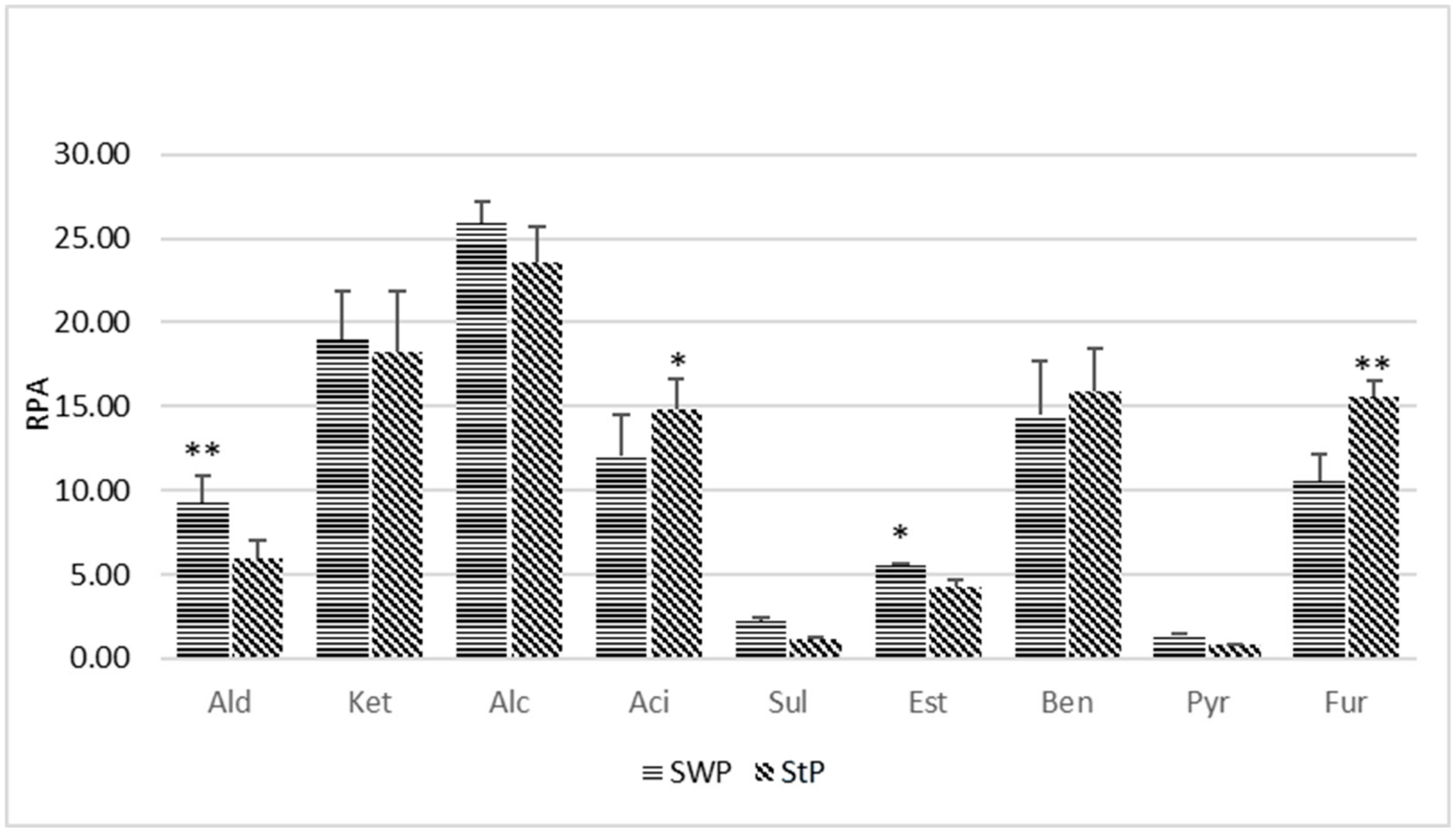
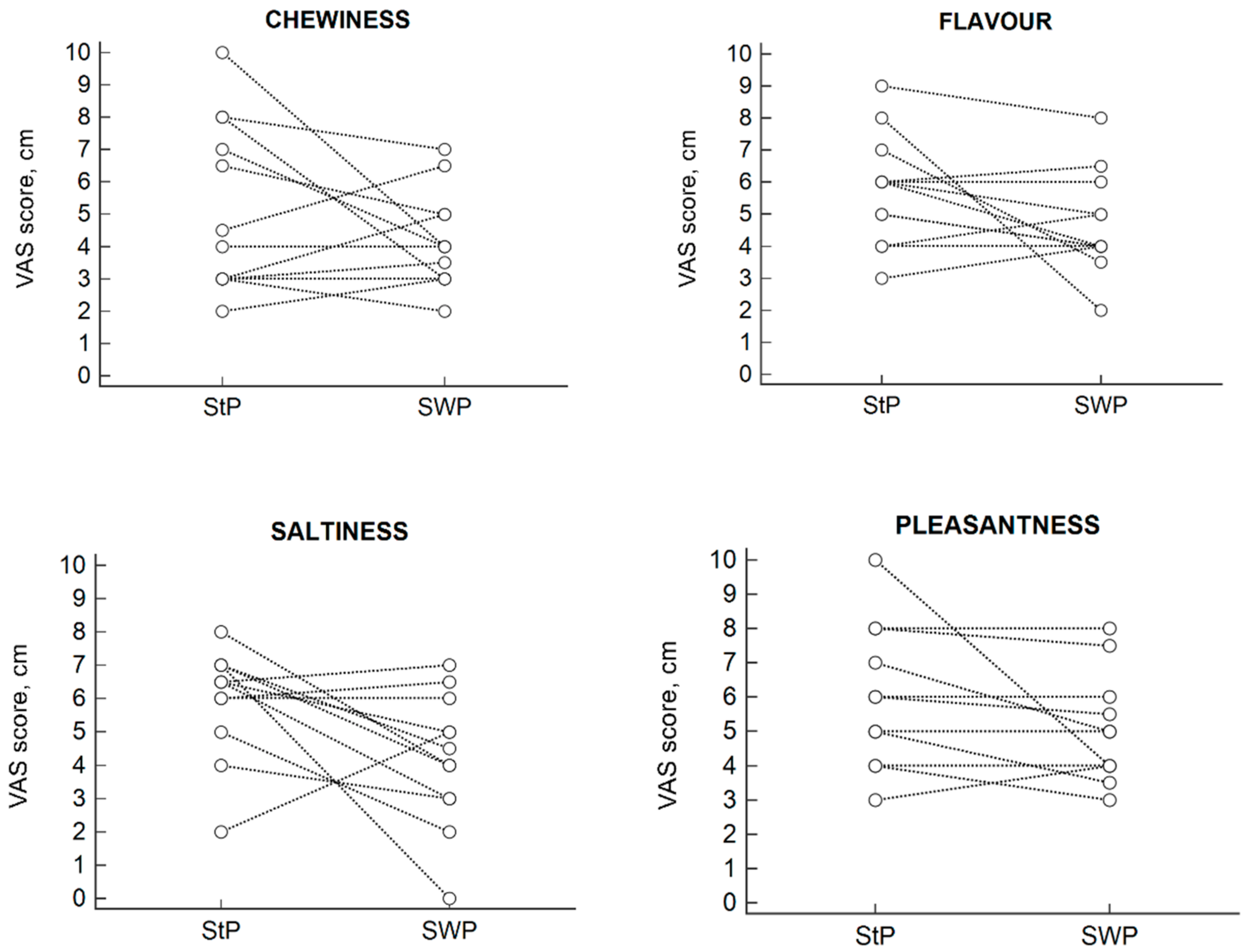
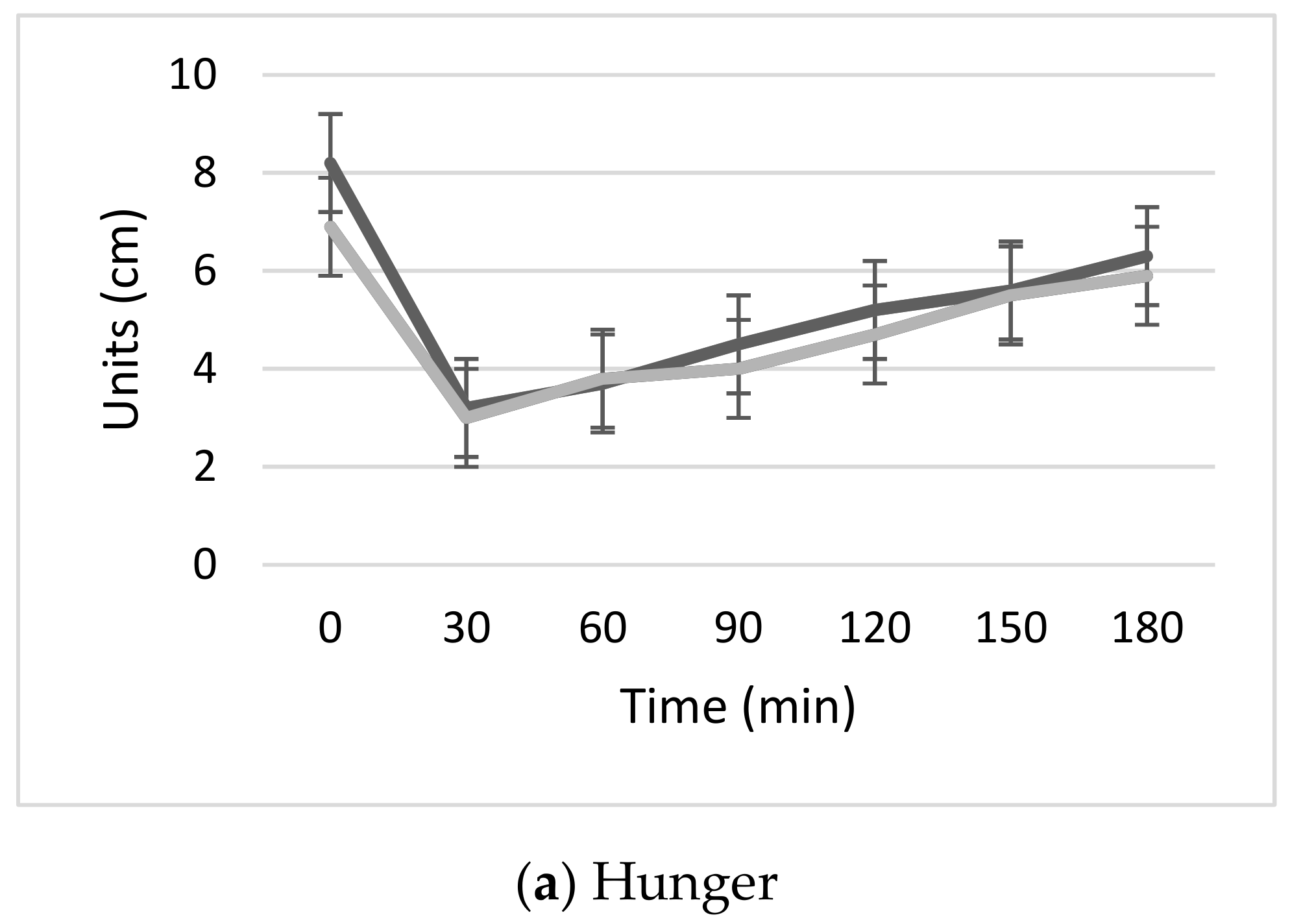
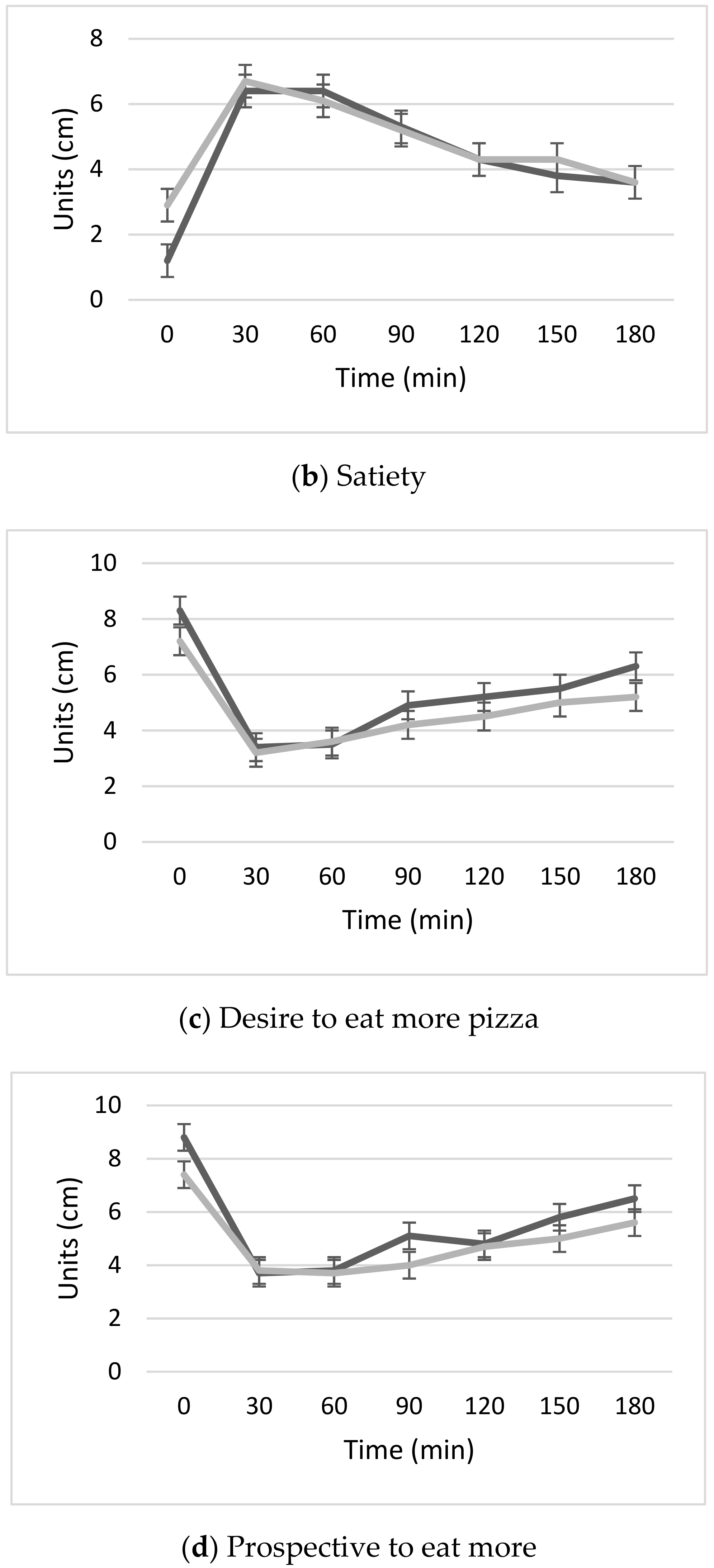
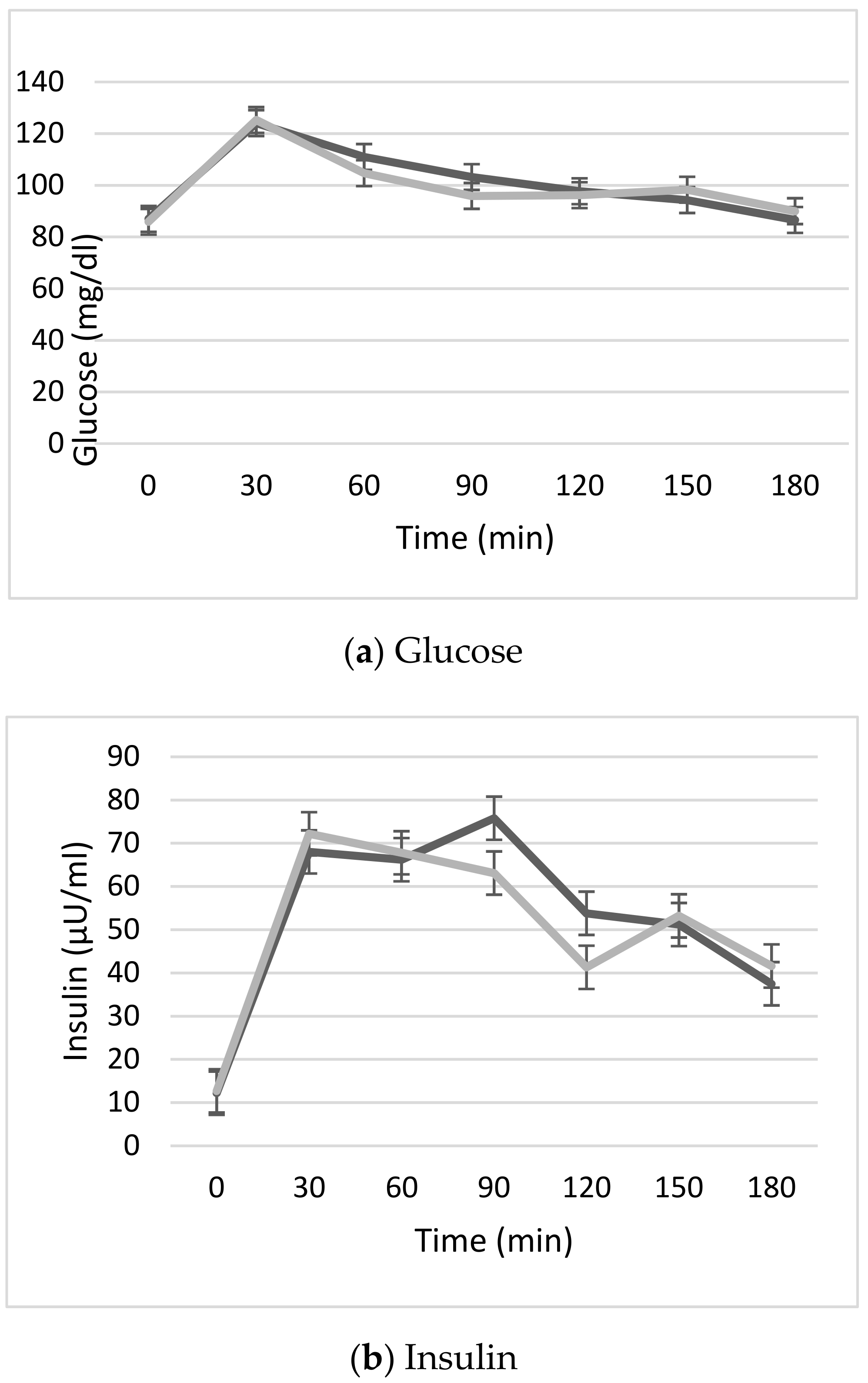
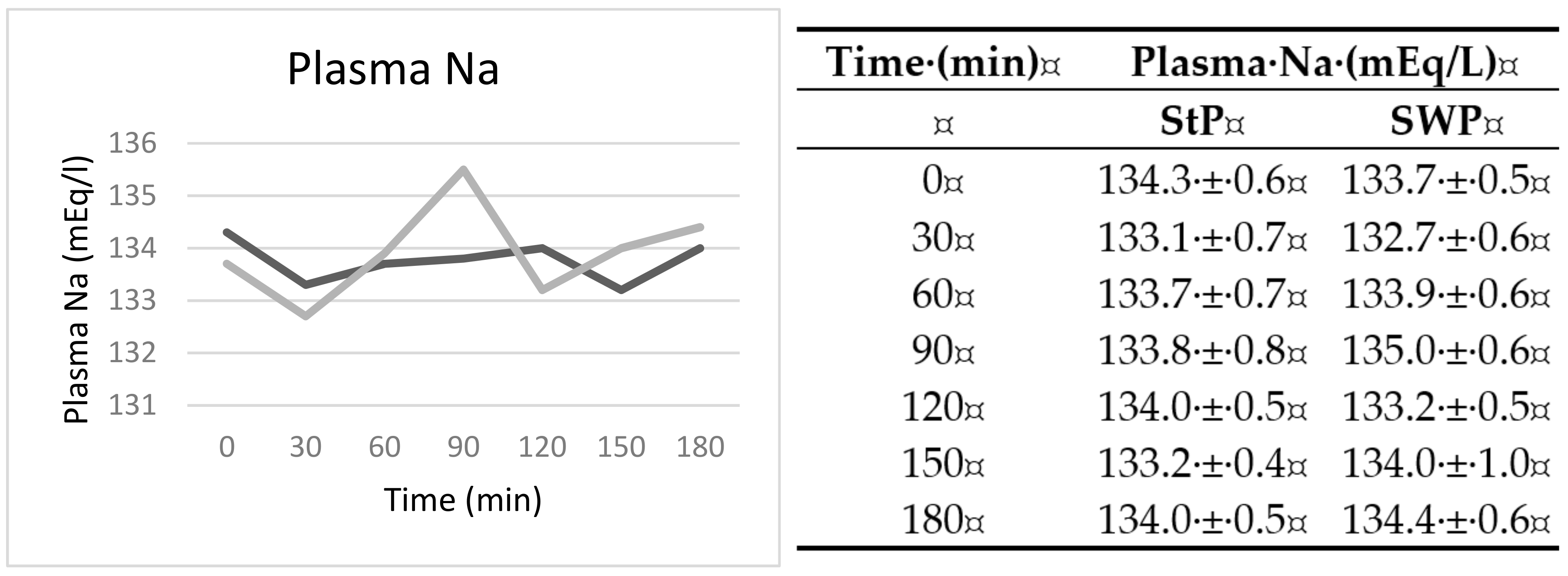
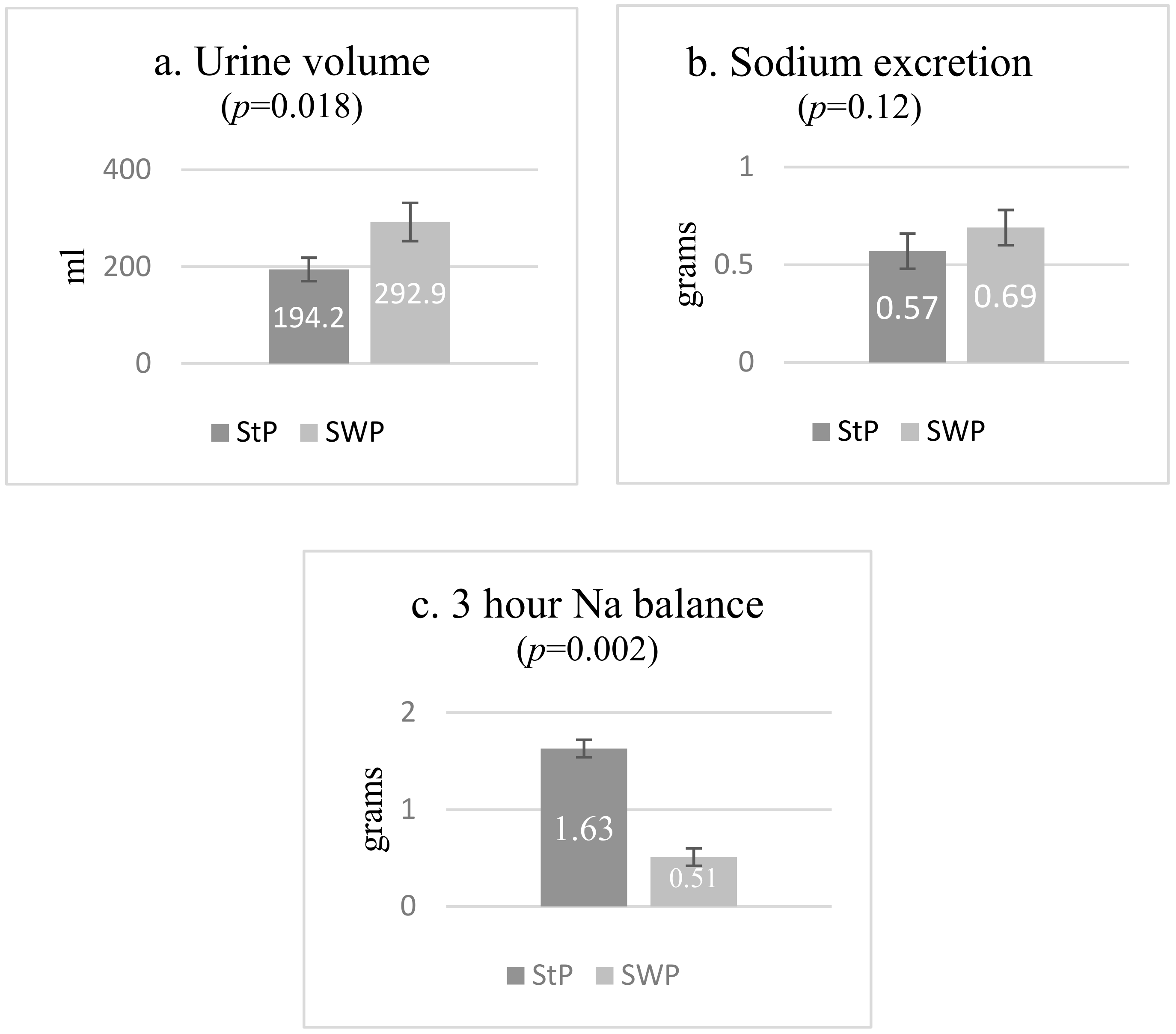
| N = 12 (5F, 7M) | Min | Max | Mean ± SD |
|---|---|---|---|
| BMI (kg/m2) | 16.1 | 30.9 | 24.8 ± 4.2 |
| P/A (SBP/DBP) (mmHg) | 102/59 | 137/81 | 117/74 ± 10/7 |
| COL tot (mg/dL) | 128.0 | 217.0 | 163.5 ± 27.5 |
| HDL (mg/dL) | 38.8 | 61.7 | 53.0 ± 7.1 |
| LDL (mg/dL) | 63.0 | 143.0 | 97.4 ± 23.8 |
| TG (mg/dL) | 39.0 | 110.0 | 65.25 ± 21.7 |
| GLU t’0 (mg/dL) | 81.0 | 94.0 | 87.0 ± 4.0 |
| INS t’0 (µU/mL) | 5.8 | 22.3 | 12.2 ± 5.5 |
| Na t’0 (mMol/L) | 130.1 | 136.9 | 134.3 ± 2.0 |
| Micronutrient | StP | % of Recommended AI or PRI StP | SWP | % of Recommended AI or PRI SWP |
|---|---|---|---|---|
| Na (g) | 2.20 | 130% for people <60 years old 160% for people >60 years old | 1.20 | 80% for people <60 years old 100% for people >60 years old |
| Ca (mg) | 58.61 | 6% | 105.50 | 10% |
| K (mg) | 226.80 | 6% | 390.88 | 10% |
| Mg (mg) | 58.56 | 24% | 214.90 | 90% |
| Fe (mg) | 3.03 | 17% (women) 30% (men) | 5.66 | 31% (women) 56.5% (men) |
| I (µg) | 2.80 | 2% | 11.20 | 7.5% |
| Zn (mg) | 1.18 | 13% (women) 10% (men) | 2.15 | 24% (women) 18% for (men) |
| Se (mg) | 0.01 | 18% | 0.17 | 309% |
| StP (Mean ± SEM) | SWP (Mean ± SEM) | p | |
|---|---|---|---|
| Chewness | 5.2 ± 0.8 | 4.2 ± 0.4 | 0.28 |
| Flavour | 5.8 ± 0.5 | 4.7 ± 0.5 | 0.07 |
| Saltiness | 5.9 ± 0.5 | 4.5 ± 0.5 | 0.04 |
| General pleasantness | 5.9 ± 0.6 | 5.0 ± 0.4 | 0.08 |
Publisher’s Note: MDPI stays neutral with regard to jurisdictional claims in published maps and institutional affiliations. |
© 2020 by the authors. Licensee MDPI, Basel, Switzerland. This article is an open access article distributed under the terms and conditions of the Creative Commons Attribution (CC BY) license (http://creativecommons.org/licenses/by/4.0/).
Share and Cite
Iaccarino Idelson, P.; Russo, O.; Iacone, R.; D’Elia, L.; Giacco, R.; Volpe, M.G.; Strazzullo, P. A Lower Sodium Neapolitan Pizza Prepared with Seawater in Place of Salt: Nutritional Properties, Sensory Characteristics, and Metabolic Effects. Nutrients 2020, 12, 3533. https://doi.org/10.3390/nu12113533
Iaccarino Idelson P, Russo O, Iacone R, D’Elia L, Giacco R, Volpe MG, Strazzullo P. A Lower Sodium Neapolitan Pizza Prepared with Seawater in Place of Salt: Nutritional Properties, Sensory Characteristics, and Metabolic Effects. Nutrients. 2020; 12(11):3533. https://doi.org/10.3390/nu12113533
Chicago/Turabian StyleIaccarino Idelson, Paola, Ornella Russo, Roberto Iacone, Lanfranco D’Elia, Rosalba Giacco, Maria Grazie Volpe, and Pasquale Strazzullo. 2020. "A Lower Sodium Neapolitan Pizza Prepared with Seawater in Place of Salt: Nutritional Properties, Sensory Characteristics, and Metabolic Effects" Nutrients 12, no. 11: 3533. https://doi.org/10.3390/nu12113533
APA StyleIaccarino Idelson, P., Russo, O., Iacone, R., D’Elia, L., Giacco, R., Volpe, M. G., & Strazzullo, P. (2020). A Lower Sodium Neapolitan Pizza Prepared with Seawater in Place of Salt: Nutritional Properties, Sensory Characteristics, and Metabolic Effects. Nutrients, 12(11), 3533. https://doi.org/10.3390/nu12113533







